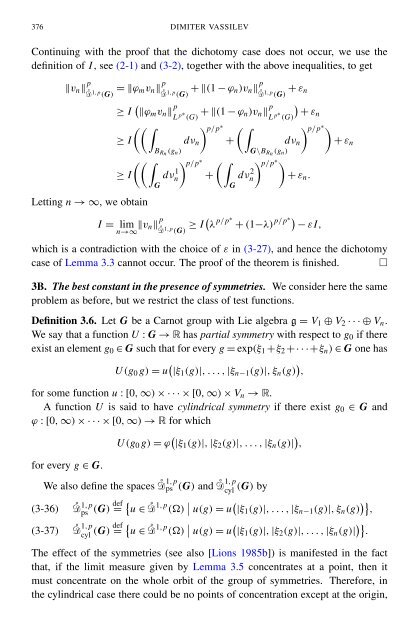Regularity near the characteristic boundary for sub-laplacian operators
Regularity near the characteristic boundary for sub-laplacian operators
Regularity near the characteristic boundary for sub-laplacian operators
Create successful ePaper yourself
Turn your PDF publications into a flip-book with our unique Google optimized e-Paper software.
376 DIMITER VASSILEV<br />
Continuing with <strong>the</strong> proof that <strong>the</strong> dichotomy case does not occur, we use <strong>the</strong><br />
definition of I , see (2-1) and (3-2), toge<strong>the</strong>r with <strong>the</strong> above inequalities, to get<br />
‖v n ‖ p˚1,p (G) = ‖ϕ mv n ‖ p˚1,p (G) + ‖(1 − ϕ n)v n ‖ p˚1,p (G) + ε n<br />
≥ I ( ‖ϕ m v n ‖ p L p∗ (G) + ‖(1 − ϕ n)v n ‖ p L (G))<br />
+ εn<br />
p∗<br />
((∫ ) p/p ∗ (∫<br />
≥ I dν n +<br />
B Rn (g n )<br />
((∫<br />
≥ I<br />
Letting n → ∞, we obtain<br />
dνn<br />
1<br />
G<br />
) p/p ∗<br />
(∫<br />
+ dνn<br />
2<br />
G<br />
) p/p ∗)<br />
dν n + ε n<br />
G\B Rn (g n )<br />
) p/p ∗)<br />
+ ε n .<br />
I = lim<br />
n→∞ ‖v n‖ p˚1,p (G) ≥ I ( λ p/p∗ + (1−λ) p/p∗ )<br />
− εI,<br />
which is a contradiction with <strong>the</strong> choice of ε in (3-27), and hence <strong>the</strong> dichotomy<br />
case of Lemma 3.3 cannot occur. The proof of <strong>the</strong> <strong>the</strong>orem is finished. □<br />
3B. The best constant in <strong>the</strong> presence of symmetries. We consider here <strong>the</strong> same<br />
problem as be<strong>for</strong>e, but we restrict <strong>the</strong> class of test functions.<br />
Definition 3.6. Let G be a Carnot group with Lie algebra g = V 1 ⊕ V 2 · · · ⊕ V n .<br />
We say that a function U : G → has partial symmetry with respect to g 0 if <strong>the</strong>re<br />
exist an element g 0 ∈ G such that <strong>for</strong> every g = exp(ξ 1 +ξ 2 +· · ·+ξ n ) ∈ G one has<br />
U(g 0 g) = u ( |ξ 1 (g)|, . . . , |ξ n−1 (g)|, ξ n (g) ) ,<br />
<strong>for</strong> some function u : [0, ∞) × · · · × [0, ∞) × V n → .<br />
A function U is said to have cylindrical symmetry if <strong>the</strong>re exist g 0 ∈ G and<br />
ϕ : [0, ∞) × · · · × [0, ∞) → <strong>for</strong> which<br />
<strong>for</strong> every g ∈ G.<br />
U(g 0 g) = ϕ ( |ξ 1 (g)|, |ξ 2 (g)|, . . . , |ξ n (g)| ) ,<br />
We also define <strong>the</strong> spaces ˚1,p ps (G) and ˚1,p (G) by<br />
(3-36)<br />
(3-37)<br />
cyl<br />
˚ 1,p def<br />
ps (G) = { u ∈ ˚1,p () ∣ u(g) = u ( |ξ 1 (g)|, . . . , |ξ n−1 (g)|, ξ n (g) )} ,<br />
˚ 1,p def<br />
cyl<br />
(G) = { u ∈ ˚1,p () ∣ u(g) = u ( |ξ 1 (g)|, |ξ 2 (g)|, . . . , |ξ n (g)| )} .<br />
The effect of <strong>the</strong> symmetries (see also [Lions 1985b]) is manifested in <strong>the</strong> fact<br />
that, if <strong>the</strong> limit measure given by Lemma 3.5 concentrates at a point, <strong>the</strong>n it<br />
must concentrate on <strong>the</strong> whole orbit of <strong>the</strong> group of symmetries. There<strong>for</strong>e, in<br />
<strong>the</strong> cylindrical case <strong>the</strong>re could be no points of concentration except at <strong>the</strong> origin,
















